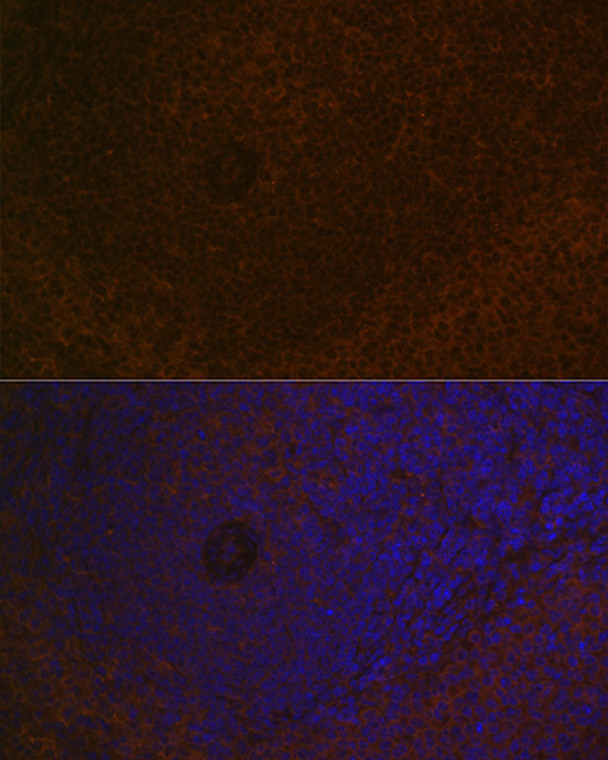| Host: |
Rabbit |
| Applications: |
WB/IHC/IF |
| Reactivity: |
Human/Mouse/Rat |
| Note: |
STRICTLY FOR FURTHER SCIENTIFIC RESEARCH USE ONLY (RUO). MUST NOT TO BE USED IN DIAGNOSTIC OR THERAPEUTIC APPLICATIONS. |
| Short Description: |
Rabbit monoclonal antibody anti-CARD11 (1055-1154) is suitable for use in Western Blot, Immunohistochemistry and Immunofluorescence research applications. |
| Clonality: |
Monoclonal |
| Clone ID: |
S6MR |
| Conjugation: |
Unconjugated |
| Isotype: |
IgG |
| Formulation: |
PBS with 0.02% Sodium Azide, 0.05% BSA, 50% Glycerol, pH7.3. |
| Purification: |
Affinity purification |
| Dilution Range: |
WB 1:500-1:2000IHC-P 1:50-1:200IF/ICC 1:50-1:200 |
| Storage Instruction: |
Store at-20°C for up to 1 year from the date of receipt, and avoid repeat freeze-thaw cycles. |
| Gene Symbol: |
CARD11 |
| Gene ID: |
84433 |
| Uniprot ID: |
CAR11_HUMAN |
| Immunogen Region: |
1055-1154 |
| Immunogen: |
A synthetic peptide corresponding to a sequence within amino acids 1055-1154 of human CARD11 (Q9BXL7). |
| Immunogen Sequence: |
EAGIGCTRDLIKSNIYPIVL FIRVCEKNIKRFRKLLPRPE TEEEFLRVCRLKEKELEALP CLYATVEPDMWGSVEELLRV VKDKIGEEQRKTIWVDEDQL |
| Tissue Specificity | Detected in adult peripheral blood leukocytes, thymus, spleen and liver. Also found in promyelocytic leukemia HL-60 cells, chronic myelogenous leukemia K-562 cells, Burkitt's lymphoma Raji cells and colorectal adenocarcinoma SW480 cells. Not detected in HeLaS3, MOLT-4, A-549 and G431 cells. |
| Post Translational Modifications | Phosphorylation at Ser-559, Ser-644 and Ser-652 by PRKCB and PRKCQ leads to a shift from an inactive to an active form that activates the NF-kappa-B signaling. |
| Function | Adapter protein that plays a key role in adaptive immune response by transducing the activation of NF-kappa-B downstream of T-cell receptor (TCR) and B-cell receptor (BCR) engagement. Transduces signals downstream TCR or BCR activation via the formation of a multiprotein complex together with BCL10 and MALT1 that induces NF-kappa-B and MAP kinase p38 (MAPK11, MAPK12, MAPK13 and/or MAPK14) pathways. Upon activation in response to TCR or BCR triggering, CARD11 homooligomerizes to form a nucleating helical template that recruits BCL10 via CARD-CARD interaction, thereby promoting polymerization of BCL10 and subsequent recruitment of MALT1: this leads to I-kappa-B kinase (IKK) phosphorylation and degradation, and release of NF-kappa-B proteins for nuclear translocation. Its binding to DPP4 induces T-cell proliferation and NF-kappa-B activation in a T-cell receptor/CD3-dependent manner. Promotes linear ubiquitination of BCL10 by promoting the targeting of BCL10 to RNF31/HOIP. Stimulates the phosphorylation of BCL10. Also activates the TORC1 signaling pathway. |
| Protein Name | Caspase Recruitment Domain-Containing Protein 11Card-Containing Maguk Protein 1Carma 1 |
| Database Links | Reactome: R-HSA-1169091Reactome: R-HSA-202424Reactome: R-HSA-2871837Reactome: R-HSA-5607764 |
| Cellular Localisation | CytoplasmMembrane RaftColocalized With Dpp4 In Membrane Rafts |
| Alternative Antibody Names | Anti-Caspase Recruitment Domain-Containing Protein 11 antibodyAnti-Card-Containing Maguk Protein 1 antibodyAnti-Carma 1 antibodyAnti-CARD11 antibodyAnti-CARMA1 antibody |
Information sourced from Uniprot.org
12 months for antibodies. 6 months for ELISA Kits. Please see website T&Cs for further guidance
















